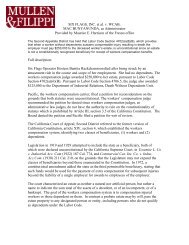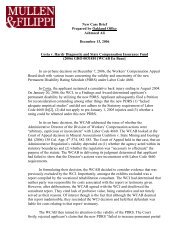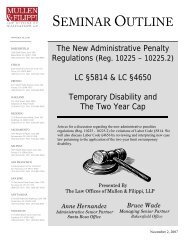Brodie v. WCAB, Welcher v. WCAB
Brodie v. WCAB, Welcher v. WCAB
Brodie v. WCAB, Welcher v. WCAB
Create successful ePaper yourself
Turn your PDF publications into a flip-book with our unique Google optimized e-Paper software.
New Case Brief<br />
Prepared by Stockton Office<br />
Tracy J. Wilkison, Esq.<br />
May 3, 2007<br />
<strong>Brodie</strong> v. <strong>WCAB</strong>, <strong>Welcher</strong> v. <strong>WCAB</strong><br />
S146979, S147030<br />
Supreme Court of California<br />
May 3, 2007<br />
The issue presented in this case is how an injured worker’s current level of permanent disability<br />
should be discounted for a previous industrial or non-industrial disability.<br />
On April 19, 2004 SB899 was adopted into law. In addition to many other changes, this law<br />
revised Labor Code Section 4663 and repealed Labor Code Section 4750. Those two sections of<br />
the California Labor Code were the basis of the California Supreme Court’s decision in Fuentes<br />
v. Workers’ Compensation Appeals Bd. (1976) 16 Cal.3d 1 (Fuentes). That decision held that<br />
the percentage of an applicant’s pre-existing permanent disability should be deducted from the<br />
overall percentage of his/her current level of permanent disability, leaving the employer liable<br />
for only the percentage of the injured worker’s disability resulting from the current work related<br />
injury. This method of apportionment became known as “Formula A.”<br />
Because SB899 did away with the statutes that Fuentes was based upon, applicants’ attorneys<br />
challenged the legitimacy of “Formula A”. The California Supreme Court granted review to<br />
resolve a split in authority between Court of Appeal decisions addressing apportionment. In<br />
<strong>Brodie</strong> v. Workers’ Compensation Appeals Bd., the First District Court of Appeal concluded that<br />
the percentage of disability awarded to the applicant for his previous injury should be converted<br />
to the current dollar value of that percentage of disability and that the current dollar value should<br />
then be deducted from the dollar value of the applicant’s overall current level of permanent<br />
disability. That method of apportionment results in higher costs to employers and/or insurance<br />
carriers. In <strong>Welcher</strong> v. Workers’ Compensation Appeals Bd., Strong v. Workers’ Compensation<br />
Appeals Bd., Lopez v. Workers’ Compensation Appeals Bd. and Williams v. Workers’<br />
Compensation Appeals Bd. the Third District Court of Appeal consolidated the cases and held<br />
that the Fuentes formula still applied and upheld decisions that deducted the percentage of an<br />
injured worker’s pre-existing disability from the percentage an injured worker’s current overall<br />
level of permanent disability.<br />
In its decision The California Supreme Court unanimously upheld the apportionment formula<br />
adopted in Fuentes. The Court discussed the fact that the Legislature’s intent behind SB899 was<br />
to address skyrocketing workers’ compensation costs and stated that the revision of Labor Code<br />
Section 4663 and the repeal of Labor Code Section 4750 were necessary to carry out the<br />
Legislature’s intent to allow for apportionment based on causation. The Court held that while<br />
there was clear intent to charge employers only with that percentage of permanent disability<br />
directly caused by the current industrial injury and thereby the method of identifying the
percentage of permanent disability an employer is responsible for, there was no intent to change<br />
how one calculates the compensation due for that disability once a percentage is determined.







